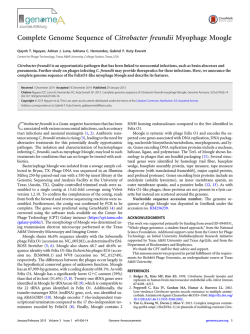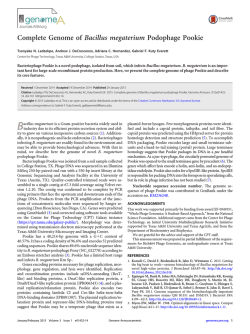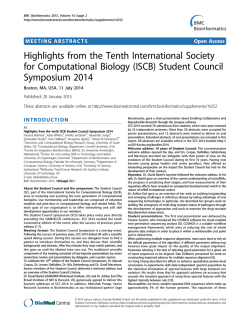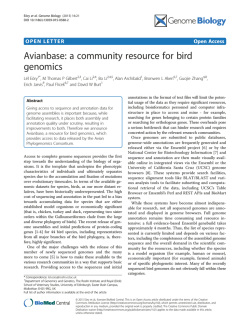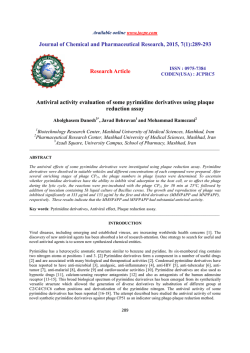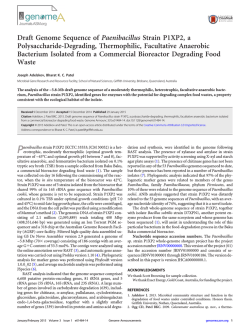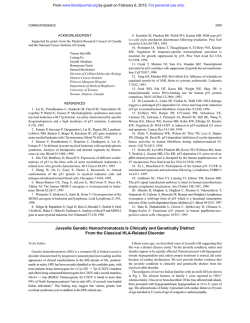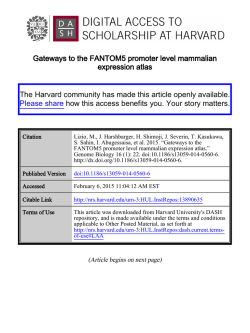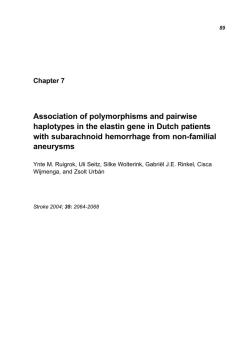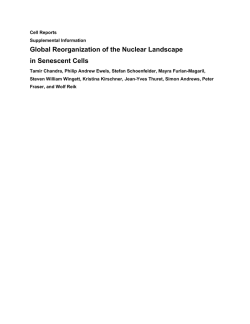
Provisional PDF - BioMed Central
Siranosian et al. BMC Bioinformatics 2015, 16(Suppl 2):A7 http://www.biomedcentral.com/1471-2105/16/S2/A7 MEETING ABSTRACT Open Access Tetranucleotide usage in mycobacteriophage genomes: alignment-free methods to cluster phage and infer evolutionary relationships Benjamin Siranosian1,2*, Emma Herold2, Edward Williams2, Chen Ye2, Christopher de Graffenried3 From Tenth International Society for Computational Biology (ISCB) Student Council Symposium 2014 Boston, MA, USA. 11 July 2014 Background The genomic sequences of phages isolated on mycobacterial hosts are diverse, mosaic and often share little nucleotide similarity. However, about 30 unique types have been isolated, allowing most phage to be grouped into clusters and further into subclusters [1]. Many tools for the analysis of mycobacteriophage genomes depend on sequence alignment or knowledge of gene content. These methods are computationally expensive, can require significant manual input (for example, gene annotation) and can be ineffective for significantly diverged sequences [2]. We evaluated tetranucleotide usage in mycobacteriophages as an alternative to alignment-based methods for genome analysis. Description We computed tetranucleotide usage deviation, the ratio of observed counts of 4-mers in a genome to the expected count under a null model [3]. Tetranucleotide usage deviation is comparable for members of the same phage subcluster and distinct between subclusters. Neighbor joining phylogenetic trees were constructed on pairwise Euclidean distances between all genomes in the mycobacteriophage database. In almost every case, phage were placed in a monophyletic clade with members of the same subcluster. With few exceptions, trees computed from tetranucleotide usage deviation accurately reconstruct trees based on gene content for a subset of the mycobacteriophage population (Figure 1). We also evaluated the possibility of assigning clusters to unknown phage based on tetranucleotide usage deviation. Under a * Correspondence: [email protected] 1 Center for Computational Molecular Biology, Brown University, Providence, RI, USA Full list of author information is available at the end of the article simple nearest neighbor classifier, cluster assignments were recovered at a frequency greater than 98%. In addition, we looked for evidence of horizontal gene transfer by using tetranucleotide difference index, a measure of the deviation in tetranucleotide usage from the genomic mean in a sliding window across the genome [3]. Tetranucleotide difference index plots showed a strong spike at the end of cluster L mycobacteriophages, which could indicate horizontal gene transfer in the region. Conclusions Genome analysis based on tetranucleotide usage shows promise for evaluating host-parasite coevolution and gene exchange within the mycobacteriophage population. These methods are computationally inexpensive and independent of gene annotation, making them optimal candidates for further research aimed at clustering phage and determining evolutionary relationships. Code for genome analysis and data used in this project are freely available at https://github.com/bsiranosian/ tango_final. Authors’ details 1 Center for Computational Molecular Biology, Brown University, Providence, RI, USA. 2Division of Biology and Medicine, Brown University, Providence, RI, USA. 3Department of Molecular Microbiology and Immunology, Brown University, Providence, RI, USA. Published: 28 January 2015 References 1. Hatfull GF: Mycobacteriophages: Windows into Tuberculosis. PLoS Pathog 2014, 10:e1003953. 2. Vinga S, Almeida J: Alignment-free sequence comparison-a review. Bioinformatics 2003, 19:513-523. 3. Pride DT, Wassenaar TM, Ghose C, Blaser MJ: Evidence of host-virus coevolution in tetranucleotide usage patterns of bacteriophages and eukaryotic viruses. BMC Genomics 2006, 7:8. © 2015 Siranosian et al; licensee BioMed Central Ltd. This is an Open Access article distributed under the terms of the Creative Commons Attribution License (http://creativecommons.org/licenses/by/4.0), which permits unrestricted use, distribution, and reproduction in any medium, provided the original work is properly cited. The Creative Commons Public Domain Dedication waiver (http://creativecommons.org/publicdomain/zero/1.0/) applies to the data made available in this article, unless otherwise stated. Siranosian et al. BMC Bioinformatics 2015, 16(Suppl 2):A7 http://www.biomedcentral.com/1471-2105/16/S2/A7 Page 2 of 2 Figure 1 A) Neighbor joining tree constructed from tetranucleotide usage deviation distances and B) tree from [4] constructed from predicted protein products in a subset of sequenced mycobacteriophages. Our method accurately places phage in a monophyletic clade with members of the same subcluster and often reconstructs relationships between subclusters. In some cases, a subcluster is not placed with other members of the cluster because of significant and conserved differences in tetranucleotide usage, such as overrepresentation of the 4-mer ‘GATC’ in cluster B3 genomes. 4. Hatfull GF, Jacobs-Sera D, Lawrence JG, Pope WH, Russell DA, Ko C-C, Weber RJ, Patel MC, Germane KL, Edgar RH, Hoyte NN, Bowman CA, Tantoco AT, Paladin EC, Myers MS, Smith AL, Grace MS, Pham TT, O’Brien MB, Vogelsberger AM, Hryckowian AJ, Wynalek JL, Donis-Keller H, Bogel MW, Peebles CL, Cresawn SG, Hendrix RW: Comparative Genomic Analysis of 60 Mycobacteriophage Genomes: Genome Clustering, Gene Acquisition, and Gene Size. Journal of Molecular Biology 2010, 397:119-143. doi:10.1186/1471-2105-16-S2-A7 Cite this article as: Siranosian et al.: Tetranucleotide usage in mycobacteriophage genomes: alignment-free methods to cluster phage and infer evolutionary relationships. BMC Bioinformatics 2015 16(Suppl 2): A7. Submit your next manuscript to BioMed Central and take full advantage of: • Convenient online submission • Thorough peer review • No space constraints or color figure charges • Immediate publication on acceptance • Inclusion in PubMed, CAS, Scopus and Google Scholar • Research which is freely available for redistribution Submit your manuscript at www.biomedcentral.com/submit
© Copyright 2026
